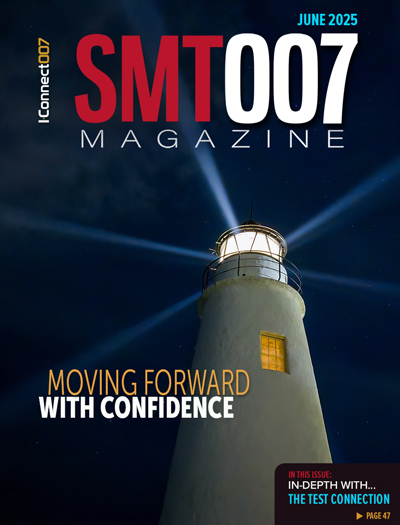-

- News
- Books
Featured Books
- smt007 Magazine
Latest Issues
Current Issue
Supply Chain Strategies
A successful brand is built on strong customer relationships—anchored by a well-orchestrated supply chain at its core. This month, we look at how managing your supply chain directly influences customer perception.

What's Your Sweet Spot?
Are you in a niche that’s growing or shrinking? Is it time to reassess and refocus? We spotlight companies thriving by redefining or reinforcing their niche. What are their insights?

Moving Forward With Confidence
In this issue, we focus on sales and quoting, workforce training, new IPC leadership in the U.S. and Canada, the effects of tariffs, CFX standards, and much more—all designed to provide perspective as you move through the cloud bank of today's shifting economic market.
- Articles
- Columns
- Links
- Media kit
||| MENU - smt007 Magazine
ANSI/ESD S20.20 Revisions
December 31, 1969 |Estimated reading time: 3 minutes
The ESD Association (ESDA) has updated and re-issued ANSI/ESD S.2020-2007 for the Development of an Electrostatic Discharge Control Program for - Protection of Electrical and Electronic Parts, Assemblies, and Equipment (Excluding Electrically Initiated Explosive Devices). This article highlights recent updates.
By the ESD Association
The ESDA created the original document in 1999 at the request of the U.S. Department of Defense (DoD) to have an industry standard for developing an ESD control program, and has since become a globally recognized standard for the industry. It is both ESDA and ANSI policy to review standards periodically to keep them up-to-date with technology within the industry. During the review process, the ESDA S2020 committee made a number of modifications to the original standard to improve clarity and accommodate supporting ESDA standards that have since become available. Following are some of the significant changes to the document.
Recommended ranges for protective elements are now requirements. For example, in the original standard, work surfaces had a recommended limit of <1×109Ω resistance to ground. In the revision, this is now a requirement.
Product qualification and periodic verification. The ESDA has issued a technical report titled “TR53, Compliance Verification of ESD Protective Equipment and Materials,” which describes test methods and equipment used for periodically testing control elements that are already in use and require less-intensive testing than products that are being evaluated for suitability. The revision refers to TR53 for periodic verification, and to the full standard for product qualification.
Tables. Two tables have been added to the document. In Table 1: Grounding/Equipotential Bonding Requirements, the auxiliary ground requirement was changed from <1Ω AC impedance to <25Ω to the equipment grounding conductor, in accordance with the National Electric Code. Table 2: Personnel Grounding Requirements, focuses on flooring and footwear grounding. For example, both STM97.1 Resistance Measurement and STM97.2 Voltage Generation are required.
Guidance. Guidance sections have been removed because they were never a required part of the standard, and caused misinterpretations. When dealing with the assessors and the facility-certification program, the standard must contain only the “shall.” Guidance information has always been located in the ESD Handbook TR20.20, the companion document for the standard.
Humidity. In the ANSI/ESD S20.20- 2007, humidity has been removed from the tables, as this is an optional element. You may choose to implement it, or design your program to be humidity-independent. A good compliance-verification program will ensure that your materials will stay within specification, regardless of humidity levels.
Garments. Garments have been classified into three categories: static control, groundable static control, and groundable static control garment systems. Each category has a specific required resistance limit to meet the purpose of the garment application.
Packaging. Packaging in or out of the ESD-protected area (EPA) shall meet requirements listed in ANSI/ESD S541, Packaging Materials for ESD-sensitive Items.
This list covers some of the major differences between the original standard and the revision. Both versions are available for free download at the ESDA website: www.esda.org. The ESDA has also developed a facility-certification program that offers companies the opportunity to receive S20.20-compliance certification from approved registrars. Facilities that choose to become certified during 2007 will use the ANSI/ESD S20.20-1999 standard as the basis for their certification. In 2008, companies will have the choice to become certified to the 1999 or 2007 version. From 2009 on, facility certifications will be based on the ANSI/ESD S20.20-2007 version only.
Conclusion
A Program Manager certification for individuals responsible for the ESD program at their facility is also available through the ESDA. This program includes a curriculum of 10 courses offered at various sites throughout the year, followed by a certification exam held at the annual EOS/ESD Symposium in September. Information on facility and individual certification is available at the ESDA website.
ESD Association is a not-for-profit, professional organization directed by volunteers dedicated to furthering the technology and understanding of electrostatic discharge. Additional information may be obtained by contacting the ESD Association at 7900 Turin Rd., Bldg. 3, Rome, NY 13440-2069. Phone: (315) 339-6937; fax: (315) 339-6793; info@esda.org; www.esda.org.


